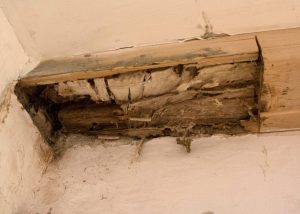
The fungus can remain invisible for a long time
An unpredictable journeyman
The “real house sponge” (Serpula lacrymans) behaves as an unpredictable journeyman. Even in cases where he already seemed successful, he can turn up again. Already two hundred years ago there were extensive treatises on the life, occurrence and the destructive action of this fungus. It can grow even at a relatively low level of wood moisture and even attack almost dry wood when it is simultaneously settled in a different area with higher humidity. With the aid of its strand mycelium or the so-called strands, the real house sponge can spread over long stretches, thereby also wood-free substances overgrown many meters. No wonder every builder shrugs when the real house sponge is mentioned.
Suddenly biological material grows out of the tiles
Sebastian Kleber *) had bought a house from the forties two months ago, a former farm with strangers. The master craftsman knows about construction work. He wanted to put the building back on, which had come to a standstill for some time. A discovery in the bathroom on the upper floor braked his striking position noticeably: when screwing a cover cap on the shower mixer, Sebastian Kleber recognized a fibrous, brown fabric. Immediately he remembers a rumor that the former tenant of the property had brought to him. House sponge should be hidden in the building.
The fungus can remain invisible for a long time
“A special feature of the real house sponge is its hidden way of life,” writes the analytical laboratory Environmental Mycology Berlin on its website. Since it reacts very sensitively to airflow, the fungus preferably develops behind wall cladding, in false ceilings and under floorboards. An acute attack can therefore often remain undetected for a very long time. Serpula lacrymans can grow, among other things, through masonry joints or walls, filling materials as well as supply channels and line slits. The colonization of masonry is also a feature which is shown in particular by the real house sponge. [Source: Environmental Mycology].
Not only wood is on the menu of the house sponge
But even the real house sponge needs organic substances like any other mushroom as food base and does not feed on the masonry. In addition to wood, it can attack other cellulosic substances, e.g. Wallpapers, books, pipe braids above even leather and potatoes. Masonry, however, plays a special role, since the fungus obviously depends on the alkaline building materials such as mortar, plaster and others. The alkaline constituents neutralize the oxalic acid it produces and it is assumed that this process is also a reason for the fact that the real house sponge occurs almost exclusively in buildings [Source: Environmental Mycology].
The laboratory test provides certainty
There should be no errors in the analysis of wood-destroying fungi. The diagnosis “house sponge” attracts a rats tail at investigations, at the end of which possibly a complex rehabilitation stands. In the case of the mold fungi from environmental mycology in Berlin, the chief takes the investigation of house sponge himself into the hand. Managing Director Christoph Trautmann is an expert in the field of mold fungi and combating wood protection. His judgment after the examination of the sample material of Sebastian Kleber is clear: the infestation is actually Serpula lacrymans.
The client needs a rehabilitation concept
The German DIN 68800 part 4 provides important information on the rehabilitation of buildings that are populated by Serpula lacrymans. Based on this, the planning office Schilling in Munich proposed the following step concept:
• Determination of the extent of damage according to size, static relevance and fungi
• Detecting and eliminating the causes of increased humidity and drying of the damage areas
• Removing contaminated materials, mycelium and fruit bodies
• Expansion of infected timber components, including the cutting and removal of flanking building materials, as far as possible
• Treatment of remaining wood components with preventive wood preservatives
• In case of infestation by real house sponge: treatment of masonry with sponges
• Installation of new structures in the field of damage either free from wood or impregnated
Only use qualified companies
The renovation of buildings with wood-destroying fungi requires high expertise and experience. For this purpose, the German Wood and building protection association lists on its website companies that meet the standards of DIN 68800 part 4.
*) name changed
